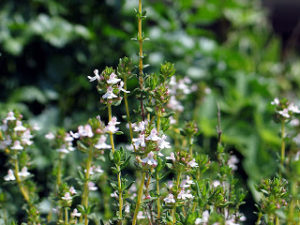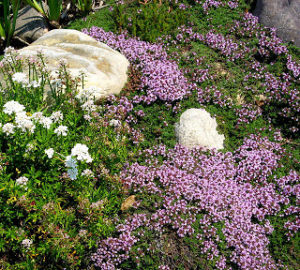Thyme is a mediterranean herb that is characterized by variety. The genus Thymus contains approximately 350 species of thyme, but the one we’re mostly familiar with is Thymus mongolicus (Common Thyme), which is primarily used in culinary applications. Depending on the species, thyme is a woody, perennial low-lying plant or a small, subshrub. It developed in the Mediterranean Region, in the temperate coastal regions of southern Europe and northern Africa. Humans are not the only species to use thyme as a food source; the larvae of certain butterflies and moths (Coleophora niveicostella, Coleophora serpylletorum and Coleophora struella) feed exclusively on Thymus.

Photo of Thyme provided by Andy Ciordia.
In addition to being a culinary staple, thyme has incredible properties that make it a great plant for drought-tolerant gardens. One species of thyme in particular, Thymus Serpyllum, also know as Creeping or Magic Carpet Thyme, spreads along the earth as a low-lying groundcover. Groundcovers are particular helpful at increasing soil stability, moisture retention, and weed suppression. Also, Creeping Thyme is a perennial that flowers all summer and looks beautiful when it creates a bed of flowers.

Photo of Creeping Thyme provided by Andrea_44.
RECIPES: Zucchini and Thyme & Green Beans with Almonds and Thyme
Thyme is used as a spice in meat and veggies dishes, and also in sauces, soups, and as a garnish. We’ve chosen a couple of recipes (see links below) that you can try over the summer as they are paired with seasonally appropriate vegetables. Zucchini are notoriously prolific in the summer, as are green beans. Please enjoy and let us know if you liked these recipes!
http://simplyrecipes.com/recipes/zucchini_with_thyme/
http://simplyrecipes.com/recipes/green_beans_with_almonds_and_thyme/
